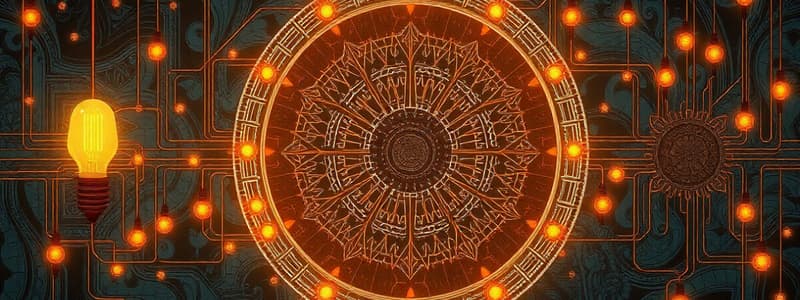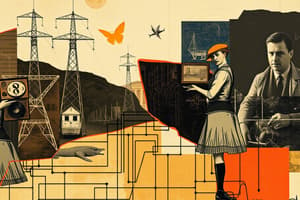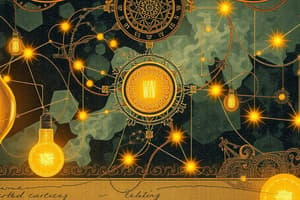Podcast
Questions and Answers
What component in an electric circuit primarily provides electrical energy?
What component in an electric circuit primarily provides electrical energy?
- Switch
- Source (correct)
- Load
- Conductor
In a series circuit, how is the total voltage distributed among the components?
In a series circuit, how is the total voltage distributed among the components?
- According to the current flow
- Proportional to their resistance (correct)
- Equally across all components
- It remains constant throughout
Which equation correctly represents Ohm's Law?
Which equation correctly represents Ohm's Law?
- I = V / R
- V = I * R (correct)
- R = V + I
- P = V / R
What is the unit of measurement for electrical resistance?
What is the unit of measurement for electrical resistance?
How is total resistance calculated in a parallel circuit?
How is total resistance calculated in a parallel circuit?
Which of the following represents the power equation using current and voltage?
Which of the following represents the power equation using current and voltage?
What type of circuit is characterized by components connected end-to-end sharing the same current?
What type of circuit is characterized by components connected end-to-end sharing the same current?
What is the term used for the total amount of electrical work done measured in Joules or kilowatt-hours?
What is the term used for the total amount of electrical work done measured in Joules or kilowatt-hours?
Flashcards
Electric Circuit
Electric Circuit
The path through which electric current flows, consisting of a source, load, conductor, and switch.
Source (in an electric circuit)
Source (in an electric circuit)
A component that provides electrical energy to the circuit, such as a battery or generator.
Load (in an electric circuit)
Load (in an electric circuit)
A device that uses electrical energy, like a light bulb, motor, or resistor.
Conductor (in an electric circuit)
Conductor (in an electric circuit)
Signup and view all the flashcards
Switch (in an electric circuit)
Switch (in an electric circuit)
Signup and view all the flashcards
Series Circuit
Series Circuit
Signup and view all the flashcards
Parallel Circuit
Parallel Circuit
Signup and view all the flashcards
Current (I)
Current (I)
Signup and view all the flashcards
Study Notes
Basic Components
- An electric circuit is a closed path that allows electric current to flow.
- Essential components include:
- Source: Provides the electrical energy (e.g., battery, generator).
- Load: Device that consumes electrical energy (e.g., light bulb, motor).
- Conductor: Material that allows current to flow easily (e.g., copper wire).
- Switch: Controls the flow of current (e.g., on/off switch).
- Different circuit types include:
- Series: Components are connected end-to-end, sharing the same current.
- Parallel: Components are connected across each other, sharing the same voltage.
Current, Voltage, and Resistance
- Current (I): The rate of flow of electric charge. Measured in Amperes (A).
- Voltage (V): The potential difference that drives the current. Measured in Volts (V).
- Resistance (R): The opposition to current flow. Measured in Ohms (Ω).
- Ohm's Law: Relates these three quantities: V = I * R
Circuit Analysis
- Series Circuits:
- Total resistance is the sum of individual resistances (Rtotal = R1 + R2 + ...).
- Current is the same throughout the circuit.
- Voltage is divided across each component proportionally to its resistance.
- Parallel Circuits:
- Total resistance is calculated using the reciprocal formula (1/Rtotal = 1/R1 + 1/R2 + ...).
- Voltage is the same across each component.
- Current is divided among the components inversely proportional to their resistances.
Circuit Diagrams
- Schematic diagrams: Use standardized symbols to represent circuit components and connections.
- Wiring diagrams: Show the physical layout and connections used in a wiring project.
Power and Energy
- Power (P): The rate at which electrical energy is used. Measured in Watts (W).
- Power Equation (using current and voltage): P = I * V
- Power Equation (using resistance and voltage): P = V2 / R
- Power Equation (using resistance and current): P = I2 * R
- Energy (E): The total amount of electrical work done. Measured in Joules (J) or kilowatt-hours (kWh).
Types of Circuits and Applications
- Simple circuits: Contain few components and are used for basic demonstrations.
- Complex circuits: Contain multiple components and are used in various applications, such as computers, appliances, and electronic devices.
- AC (Alternating Current) circuits: The current alternates direction periodically. Common in household power delivery.
- DC (Direct Current) circuits: The current flows in one direction. Common in battery-powered devices.
- Combination circuits: Often combine features of series and parallel circuits.
Safety Precautions
- Short circuits: Can lead to high current flow and potential fire hazards.
- Proper insulation: Essential to prevent electric shocks.
- Circuit breakers: Protect circuits from excessive current.
- Grounding: Essential to reduce electrical shock risk.
Studying That Suits You
Use AI to generate personalized quizzes and flashcards to suit your learning preferences.




